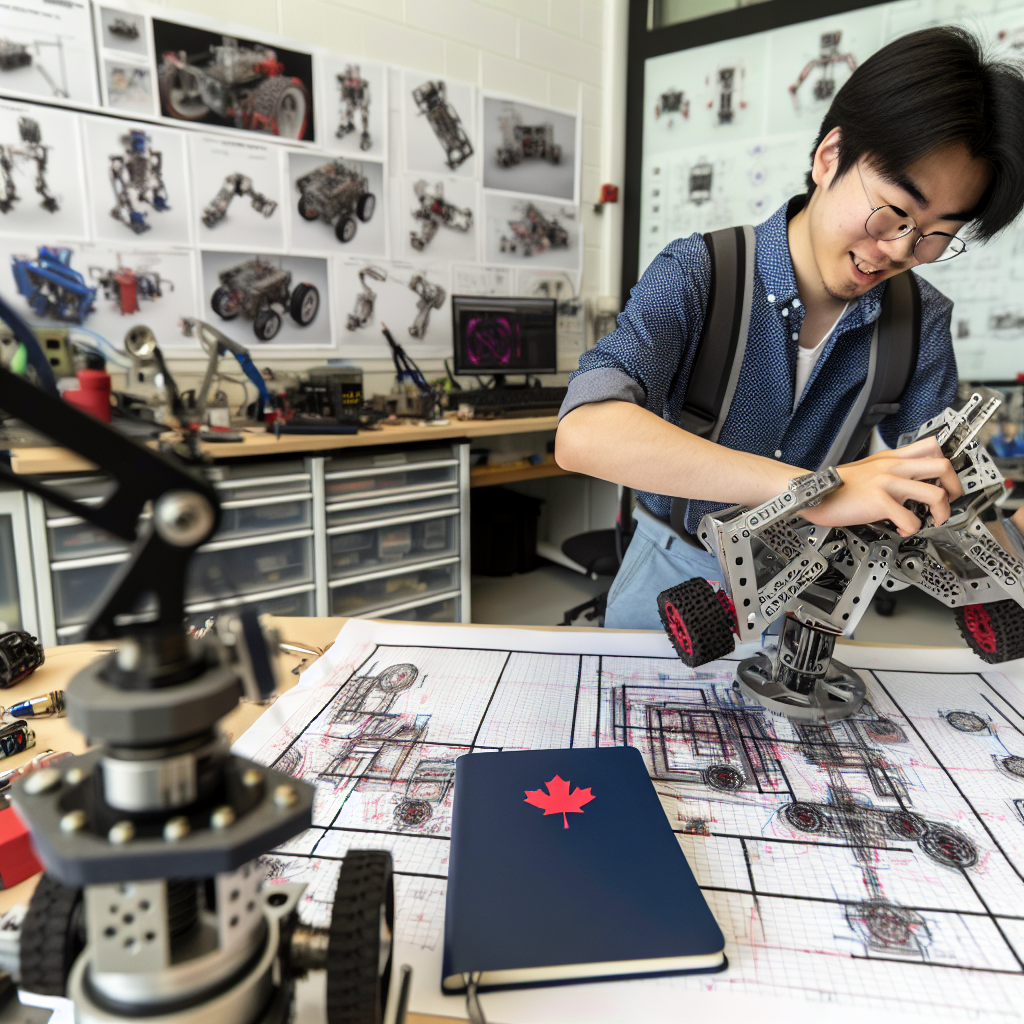Overview of Mechatronics and Mechanical Engineering
Defining Mechatronics
Mechatronics is an interdisciplinary field that combines engineering and technology.
It integrates mechanical engineering, electronics, computer science, and control engineering.
This blending allows for the development of smart machines and systems.
In Canada, mechatronics is gaining importance due to technological advancements.
The field focuses on automating processes across various industries.
Key Areas in Mechatronics
Several areas define the scope of mechatronics.
- Robotics integrates the design of mechanical systems with computer controls.
- Automated manufacturing enhances efficiency and precision in production lines.
- Smart sensors improve interaction between machines and their environment.
Furthermore, mechatronics plays a key role in renewable energy systems.
This includes the operation of wind turbines and solar energy systems.
Defining Mechanical Engineering
Mechanical engineering is one of the oldest engineering disciplines.
It focuses on the design, analysis, and manufacturing of mechanical systems.
This field emphasizes applying physics principles to solve practical problems.
In Canada, mechanical engineering remains a vital sector for innovation.
Key Areas in Mechanical Engineering
Mechanical engineering encompasses several important areas.
- Thermodynamics studies energy and heat transfer mechanisms.
- Fluid mechanics involves the behavior of fluids in motion and at rest.
- Manufacturing processes focus on turning raw materials into finished products.
Mechanical engineers also play crucial roles in automotive and aerospace industries.
Innovations include designing more efficient engines and safer aircraft.
Comparing the Two Fields
Mechatronics and mechanical engineering share several similarities.
Both fields require strong analytical skills and a solid foundation in physics.
They also emphasize problem-solving to improve existing technologies.
However, mechatronics leans more towards automation and electronics.
Conversely, mechanical engineering focuses on traditional mechanical systems.
Career Opportunities in Canada
Career opportunities exist across both fields in Canada.
Individuals with a background in mechatronics can work in robotics and automation.
Mechanical engineers often find roles in industries such as manufacturing and aerospace.
Moreover, both fields offer prospects in research and development.
They contribute significantly to Canada’s economy and technological landscape.
Unlock Your Career Potential
Visualize a clear path to success with our tailored Career Consulting service. Personalized insights in just 1-3 days.
Get StartedKey Differences Between Mechatronics and Mechanical Engineering
Understanding the Fields
Mechatronics combines mechanical engineering, electronics, and computer science.
It focuses on creating smart systems and automation technologies.
In contrast, mechanical engineering primarily deals with mechanical systems and machinery.
This field emphasizes the design and analysis of mechanical components.
Core Curriculum Differences
Mechatronics programs include courses in robotics and control systems.
Students learn about sensors, actuators, and embedded systems.
Mechanical engineering programs focus on thermodynamics and fluid mechanics.
They also cover material science and structural analysis.
Career Opportunities
Graduates in mechatronics can work in robotics and automation industries.
They often find roles in manufacturing and product development.
Mechanical engineering graduates typically work in industries like aerospace and automotive.
Many focus on design, maintenance, and thermal systems.
Skills and Tools
Mechatronics engineers use tools like CAD software and robotics simulators.
They require strong programming skills and knowledge of electronics.
Mechanical engineers also use CAD systems but focus more on mechanical simulations.
They apply principles of physics and mathematics in their analyses.
Industry Trends
Mechatronics is rapidly growing due to advancements in automation.
Industries are increasingly relying on integrated systems.
Mechanical engineering remains crucial for traditional manufacturing processes.
However, it is also adapting to include more technology.
Education Pathways for Mechatronics vs. Mechanical Engineering in Canada
Overview of Educational Programs
Students in Canada can choose between mechatronics and mechanical engineering programs.
Both fields offer unique educational experiences and career opportunities.
Mechatronics combines mechanical, electronic, and software engineering.
Mechanical engineering focuses primarily on the principles of mechanics.
Degree Options
Mechatronics programs typically offer bachelor’s and master’s degrees.
Many universities also provide diploma programs in mechatronics technology.
For mechanical engineering, students can pursue similar undergraduate and graduate degrees.
Institutions like the University of Toronto and McGill University lead in these programs.
Curriculum Details
The mechatronics curriculum often includes robotics, control systems, and sensor technology.
Students learn to integrate and design complex systems.
Mechanical engineering students study thermodynamics, dynamics, and materials science.
In contrast, mechanical engineers focus on the design and analysis of machines.
Hands-on Experience
Both programs emphasize practical experience through labs and projects.
Mechatronics students often work on robotics and automation projects.
Mechanical engineering students participate in design projects and internships.
Such opportunities enhance skills and boost employability upon graduation.
Certification and Licensing
Graduates in both fields can pursue licensure as Professional Engineers.
Obtaining this designation requires meeting educational and experience criteria.
Continuing education is essential for maintaining licensure in both disciplines.
Career Opportunities
Mechatronics graduates can find positions in automation and robotics industries.
They often work in sectors like aerospace, manufacturing, and healthcare.
Mechanical engineering graduates have diverse job opportunities in various fields.
They can pursue careers in automotive, energy, and construction industries.
Explore Further: Certifications That Boost Aerospace Engineering Careers
Job Market Outlook for Mechatronics and Mechanical Engineers in Canada
Current Job Market Trends
The job market for engineers in Canada continues to show steady growth.
Mechatronics engineers are finding more opportunities due to emerging technologies.
Conversely, mechanical engineers have a strong employment base as well.
Both fields are crucial in various industries, including manufacturing and technology.
Demand for Mechatronics Engineers
Mechatronics engineers are in high demand across Canada.
This demand correlates with advancements in automation and robotics.
Industries such as aerospace and automotive are leading employers in this sector.
Furthermore, the integration of AI in manufacturing boosts job prospects.
Opportunities for Mechanical Engineers
Mechanical engineers also enjoy robust job opportunities in Canada.
The construction and energy sectors are significant employers for these professionals.
Moreover, mechanical engineering roles often focus on sustainability and innovation.
Technological advancements continue to create diverse career paths.
Regional Job Market Variations
Job opportunities for engineers can vary greatly by region.
Metropolitan areas like Toronto and Vancouver show particularly high demand.
Alberta also holds promise due to its energy sector initiatives.
Conversely, smaller provinces may have fewer opportunities overall.
Salary Expectations
Salary expectations differ between mechatronics and mechanical engineers.
In general, mechatronics engineers tend to earn competitive salaries.
Mechanical engineers also receive lucrative compensation, especially in specialized fields.
Ultimately, experience and education level significantly influence earnings.
Future Outlook
The future job outlook for both fields remains positive.
Growing industries and technology integration will drive employment opportunities.
Continuous learning and skills development are essential for success.
Therefore, professionals must adapt to changing market demands to thrive.
You Might Also Like: How to Build a Portfolio for Aerospace Engineering
Core Skills Required in Mechatronics and Mechanical Engineering Fields
Understanding Mechatronics
Mechatronics combines mechanical engineering, electronics, and computer science.
It focuses on designing intelligent systems and advanced machines.
Core skills include programming, systems thinking, and robotics knowledge.
Moreover, competency in sensors and actuators is essential.
Professionals must also grasp control systems for automation.
Essential Skills in Mechanical Engineering
Mechanical engineering emphasizes the design and analysis of mechanical systems.
Critical skills encompass thermodynamics, fluid mechanics, and materials science.
Analytical thinking is crucial for solving engineering problems.
Furthermore, proficiency in CAD software assists in design processes.
Mechanical engineers should also understand manufacturing processes and techniques.
Comparing the Two Fields
While both fields require technical knowledge, their focus differs significantly.
Mechatronics emphasizes multidisciplinary integration, while mechanical engineering focuses on traditional mechanics.
Additionally, mechatronics professionals often work on complex systems for automation.
In contrast, mechanical engineers deal with machinery and structural integrity.
Both disciplines, nonetheless, require strong problem-solving skills.
Learning and Growth Opportunities
Both fields offer numerous learning paths and certifications.
Students can pursue internships in various industries to gain hands-on experience.
Moreover, continuing education keeps professionals updated with technology advancements.
Networking in relevant sectors can open doors to new opportunities.
Ultimately, pursuing advanced degrees can enhance career prospects in either field.
Delve into the Subject: Aerospace Engineering for Defense and Security

Industry Applications for Mechatronics vs. Mechanical Engineering
Overview of Mechatronics Applications
Mechatronics integrates mechanical, electrical, and software engineering.
This interdisciplinary approach enhances automation in various industries.
Common applications include robotics, manufacturing, and aerospace.
Companies like Vector Aerospace utilize mechatronics in systems design.
Automated assembly lines benefit greatly from mechatronics innovations.
Furthermore, mechatronic systems improve precision in industrial processes.
Overview of Mechanical Engineering Applications
Mechanical engineering emphasizes the design and production of machinery.
It plays a crucial role in automotive, energy, and HVAC industries.
For instance, Bombardier enhances vehicle efficiency through engineering expertise.
Mechanical engineers also focus on thermal and fluid systems.
Most importantly, they ensure product reliability and safety across industries.
Comparative Analysis of Industry Focus
Mechatronics tends to prioritize automation and smart technologies.
In contrast, mechanical engineering often emphasizes traditional systems design.
For example, robotics heavily relies on mechatronics advancements.
On the other hand, mechanical engineering supports infrastructure development.
Both fields, however, contribute significantly to innovation in Canada.
Trends Driving Industry Applications
Emerging technologies shape both mechatronics and mechanical engineering fields.
Industry 4.0 promotes the integration of IoT in manufacturing.
Mechatronics, in particular, benefits from this digital transformation.
Meanwhile, sustainable practices influence mechanical engineering design.
Companies increasingly focus on energy efficiency and waste reduction.
Discover More: Metallurgical Engineer Job Market Insights in Canada
Salary Comparisons for Mechatronics and Mechanical Engineers in Canada
Overview of Salary Trends
The salary for engineers in Canada varies significantly.
Mechatronics engineers often earn higher salaries than their mechanical counterparts.
However, this can depend on various factors such as location and experience.
In recent years, the demand for mechatronics engineers has increased.
Consequently, salaries have also seen a noticeable rise.
Average Salary Comparisons
On average, a mechatronics engineer earns around CAD 85,000 annually.
In contrast, a mechanical engineer earns roughly CAD 78,000 per year.
However, these figures can fluctuate based on specific job roles and sectors.
For instance, those working in automation may see even higher salaries.
Factors Affecting Salaries
Several factors influence salaries for engineers in Canada.
- Geographical location plays a major role.
- Educational qualifications can also impact salary levels.
- Work experience significantly affects earning potential.
- Industry type will greatly determine a salary’s upper limit.
For example, engineers in high-demand industries like robotics tend to earn more.
Further, certifications may provide an additional salary boost.
Long-Term Salary Potential
Long-term salary potential is important for career planning.
Mechatronics engineers may see a faster salary progression.
This is largely due to the growing technology sector in Canada.
In addition, opportunities for advancement often present themselves earlier.
Conversely, mechanical engineers also have solid long-term prospects.
Their experience in traditional industries remains valuable.
Implications for Career Choices
Both fields offer competitive salaries.
Mechatronics tends to yield higher immediate earnings.
Mechanical engineering provides stable earning potential over time.
Ultimately, the choice depends on personal career goals and interests.
Future Trends in Mechatronics and Mechanical Engineering Industries
Technological Innovations
Technological advancements drive the future of engineering industries.
Mechatronics integrates electronics with mechanical systems.
This integration enhances automation in various sectors.
Meanwhile, mechanical engineering focuses on improving efficiency.
These innovations lead to smarter manufacturing processes.
Industry Applications
Mechatronics finds applications in robotics and automation.
Automated processes increase productivity and reduce costs.
Mechanical engineers apply their expertise in diverse sectors.
Industries such as aerospace and automotive will benefit immensely.
Both fields contribute significantly to sustainable practices.
Workforce Development
The demand for skilled professionals rises in both fields.
Educational institutions adapt their curriculums accordingly.
Hands-on experience becomes crucial for students.
Co-op programs and internships enhance learning opportunities.
Moreover, continuous professional development remains essential.
Collaboration Across Disciplines
Mechatronics and mechanical engineering increasingly collaborate.
This collaboration fosters interdisciplinary projects and solutions.
It enables the development of innovative technologies.
Furthermore, cross-discipline teams enhance problem-solving capabilities.
A holistic approach helps address complex engineering challenges.
Impact of Sustainability
Sustainability shapes the future of engineering industries.
Mechatronics and mechanical engineering must prioritize eco-friendly practices.
Energy-efficient designs reduce carbon footprints significantly.
Companies are investing in renewable energy solutions.
Green engineering principles will guide new developments.
Global Perspectives
Global trends affect local industries in Canada.
Collaboration with international companies boosts innovation.
Mechatronics and mechanical sectors must align with global standards.
Networking with global professionals opens new opportunities.
Moreover, staying updated with international trends is vital.
Additional Resources
Welcome to Mechanical and Mechatronics Engineering at the …
Master of Science in Mechanical Engineering | Cleveland State …




